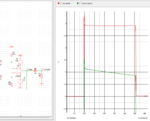deniz88
Member level 2
Hi,
i want to measure dVce/dt,
for that i used a differential amplifier(i need Vce too), after that i put a RC circuit to get dVce
problem is, dVce peak value change too fast, ADCs are soo expensive. changing RC doesnt help because output of the opamp change to fast. Circuit looks like on the picture.
i didnt use peak detector, because it needs many components, two opamp, schotky diode, cap, resistor and mosfet to discharge the capacitor.
Maybe anyone can suggest a better solution in such case,
best regards
i want to measure dVce/dt,
for that i used a differential amplifier(i need Vce too), after that i put a RC circuit to get dVce
problem is, dVce peak value change too fast, ADCs are soo expensive. changing RC doesnt help because output of the opamp change to fast. Circuit looks like on the picture.
i didnt use peak detector, because it needs many components, two opamp, schotky diode, cap, resistor and mosfet to discharge the capacitor.
Maybe anyone can suggest a better solution in such case,

best regards